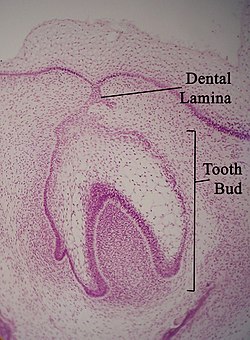Dental lamina
| Dental lamina | |
|---|---|
 Micrograph of a dental lamina and tooth bud. H&E stain. | |
| Details | |
| Identifiers | |
| Latin | lamina dentalis |
| TE | lamina_by_E5.4.1.1.1.0.3 E5.4.1.1.1.0.3 |
| Anatomical terminology | |
The dental lamina is a band of
Function
Dental lamina plays a key role in a cascade of events that contributes to teeth development.
It derived from horseshoe shaped primary epithelial band which is formed when thickened oral epithelium invaginates into the mesenchyme.[4]
A series of epithelial outgrowths deep into mesenchyme due to proliferation on the cranial portion of dental lamina give rise to future spot of deciduous teeth. Moreover, further proliferation on the leading edge of the lamina leads to permanent teeth development, as a result, successional lamina is formed when those permanent teeth succeed the 20 deciduous teeth. Since permanent molars do not have deciduous predecessor, they tend to develop from the general lamina which is also formed from dental lamina.[5]
In addition, during the bell stage of tooth development, the dental lamina helps to disconnect the interaction between the oral epithelium and developing tooth by bringing the oral epithelium fragments and the tooth germs together. Breaking up of the dental lamina leads to the development of epithelial cell clusters, some of the clusters may remain instead of degenerate, those persisted clusters, called epithelial pearls, they can delay tooth eruption by creating a small cyst on the top of the developing tooth.[4]
Hyperactivity of Dental Lamina
Hyperactivity or overgrowth of dental lamina can give rise to conditions such as Hyperdontia. Having this condition means patients have supernumerary teeth - additional teeth other than 20 primary teeth in children and 32 permanent teeth in adults.
The reasons for this condition could be any of the following:
- Dichotomy (division) of tooth buds.
- Atavism
- Gardner's syndrome
- Hyperactivity of dental lamina.
The most acknowledged theory for supernumerary teeth is hyperactivity of dental lamina.[6] On completion of the dentition, the dental lamina is usually destroyed and reabsorbed, but when remnants fail to resorb, it can continue to proliferate abnormally. This abnormal proliferation can form the extra tooth bud leading to supernumerary teeth.[7][8]
See also
References
- Gartner, L. The Essentials of Oral Histology and Embryology. Jen House Publishing Company. Baltimore, MD. 1999. pg19-20
